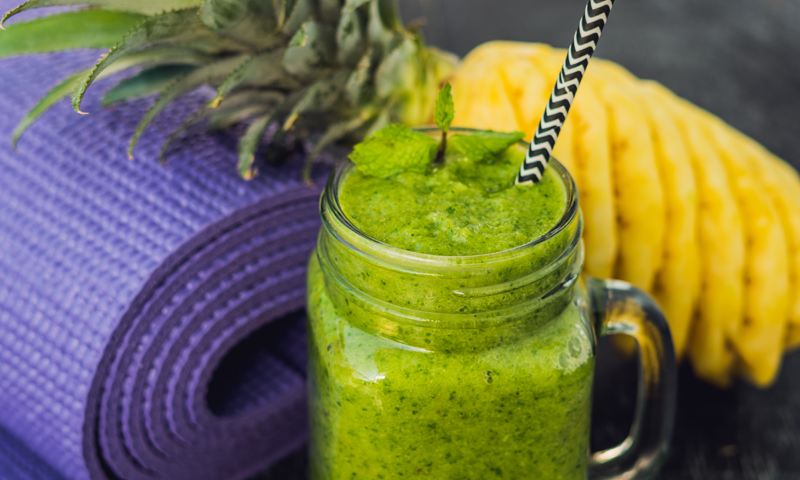
How to Reduce Bloating with Yoga
November 10, 2017
Yoga Poses for Expert Yogini’s
November 24, 2017How Yoga Influences Your Diet

Although many people choose to consume unhealthy foods, humans have a natural instinct to follow a balanced, healthy diet. If you’re somebody that finds it easy to ignore signs given by the body and mind, practising yoga may be beneficial, but always make sure you’re wearing the correct yoga gear for maximum benefit; for instance, our Kravitz Mesh Leggings allow for plenty of movement. Regularly partaking in yoga can help to enhance these natural instincts, ultimately changing what we choose to eat on a day to day basis.
Before deciding what to put in your basket it’s important to consider the purpose of food. We eat to provide the body and mind with energy, allowing the rest of our system to function sufficiently. Fresh fruit and vegetables are packed with essential vitamins and minerals; ensuring we consume the recommended daily intake of these won’t just improve our health, but our overall happiness, too. In this article we explore the connections between yoga and diet in more detail, providing a range of hints and tips about how to gain maximum benefit from our meals.
What Should You Eat?
Although traditional yoga doesn’t outline any special dietary requirements, practitioners are encouraged to eat in moderation and to consume natural foods. Often, those partaking in advanced forms of yoga are advised to eat a vegetarian diet. Studies have shown that a plant-based diet can encourage harmony between the body and mind while eating meat has been linked to an increase in tension and anger. It is also thought that a vegetarian diet can decrease desire for unhealthy foods, making it easier for individuals to maintain healthy eating habits.
Ideally, yogis should follow a pure food diet. Typically, this consists of fresh fruit and vegetables, milk, whole grains, nuts and seeds, and legumes. Within the yoga community, these foods are known as ‘Sattvic’. For maximum benefit, the diet should include a combination of raw and cooked products. These foods are easy to digest and supply the body with all the necessary nutrients for survival. Additionally, they are thought to improve vitality, encouraging feelings of clarity and peace of mind; this aspect is important within yoga as it allows practitioners to focus and reflect sufficiently. Certain foods, including meat and fish, are believed to make the mind clouded and restless. Within the yoga community, these foods are often referred to as ‘Rajasic’. Foods that are stale, processed, or frozen are known as ‘Tamasic’ foods. Consuming food from this category is thought to decrease energy levels and encourage laziness. Foods that are not cooked or chewed properly can also fall into this category.
If the majority of our diet consists of Sattvic foods, we can begin to cleanse and renew the digestive system. For maximum benefit, choose foods that are easy to digest to save vital energy for other tasks within the body.
How Much Should You Eat?
Although it’s often common practice to eat until we feel full, studies have shown that it’s better to only fill the stomach half way. This way, a quarter of the stomach can be left for water or liquids and the remaining quarter is free for digestion to occur. Leaving a sufficient amount of space for digestion is important as it means the stomach has enough room to churn the food.
Simply, it is encouraged to eat enough to satisfy hunger without the onset of feelings of laziness. At first, it may seem difficult to know when the stomach is half full – don’t worry, that’s normal! Working out how much you should be eating will take a bit of trial and error. Whenever you eat, be aware of how much food you are consuming before feeling full. Next time, try halving that amount of food. This should be the quantity that your stomach requires to be half full. Sticking to roughly the same amount each time should leave enough space in the stomach for water and digestion.
Importantly, when doing any kind of exercise, you should wear loose clothes to increase comfort and allow for flexibility. For instance, our Karl Asymmetric T-Shirt gives you plenty of room to move and feel relaxed.

When Should You Eat?
Whenever possible, you should eat your meals at the same time each day. Doing this will encourage the body to release digestive juices at a certain time so that they are ready for when the food enters your system. As the digestive secretion will be released before you consume your food, it’s important not to skip meals – otherwise, the unused digestive juices will start to be stored as excess fat. Whenever you can, aim to eat local, fresh foods rather than imported produce. Doing so may mean you have to adapt your diet season to season, but this isn’t necessarily a bad thing. Another great tip is to never eat when upset or stressed. Your emotions affect your digestion, so it’s important to only eat when you are feeling happy and relaxed. Eating slowly with a sufficient amount of chewing will encourage peaceful digestion.
Focus on the Essentials for Survival
Yoga encourages practitioners to only consume the foods needed for survival. Maintaining a balanced diet of Sattvic foods will ensure the body is getting the essential nutrients. Eating a combination of raw and cooked products is also advised.
The digestive system is one of the most important parts of our body, so it’s imperative to keep it happy and healthy. Poor digestive health can lead to a variety of debilitating health conditions, so taking good care of it while we can is advised. Being aware of the connection between yoga and diet can encourage us to make better eating choices, allowing us to achieve a level of balance between our mental and physical health.
In Summary
Regular yoga practice can stimulate our natural instincts to eat healthily. A balanced diet of fresh fruit and vegetables, milk, whole grains, nuts and seeds, and legumes will help the body to function to the best of its ability as well as cleanse and renew our digestive system.

